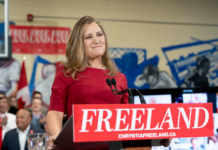Bank of Canada Deputy Governor Toni Gravelle gave a speech on Thursday that focused on the impact that immigration is having on inflation, especially its contributions to the housing crisis.
Housing construction has not managed to outpace the increased demand brought on by record-levels of immigration, which in turn increases the cost of shelter.
Gravelle also emphasized that he would like to see more downward momentum in inflation before making any further commitments regarding future interest rate hikes.
The Bank of Canada announced that it would be keeping its policy rate at 5% on Wednesday, however, they warned of possible increases in the future.
Gravelle said the economy is “roughly in balance” as inflation begins to decline and consumer spending slows down. The central bank still warns that things have not improved to such a level where it can take further rate hikes off the table.
“While we saw some welcome improvement in inflation measures in October, we must remember it’s just one month. We need to see further progress,” said Gravelle during his speech in Windsor, Ont.
Many economists believe that interest rates have already peaked and that the Bank of Canada will begin reducing rates by mid-2024. The central bank has yet to confirm any such speculation and Gravelle’s speech did not lean towards any changes regarding a less strict monetary policy.
Instead, Gravelle focused on how high immigration levels are contributing to inflation and the direct effects it’s having on housing and rental costs.
Overall, inflation fell to 3.1% in October from its peak of 8.1% in June 2022, however, the cost of housing continues to climb exponentially. This is in part due to the bank’s rate, which has resulted in higher mortgage costs but it’s also tied to higher-than-average levels of immigration over the past several years.
“Canada’s housing supply has not kept pace with recent increases in immigration. This is different from the United States where housing construction has been more flexible to respond to population shifts and where rent inflation is expected to continue to decline,” said Gravelle, noting that Canada has had the highest population growth of any G7 country since 2016.
Even more recently, immigration targets have jumped up by 50% since 2019, bludgeoning the construction industry and the cost of housing.
“This jump in demographic demand coupled with existing structural supply issues could explain why rent inflation continues to climb in Canada. It also helps explain, in part, why housing prices have not fallen as much as we expected,” said Gravelle.
“When newcomer arrivals picked up sharply in early 2022, that steady decline in the vacancy rate became a cliff. Canada’s vacancy rate has now reached a historical low,” he said.
High levels of immigration can be beneficial to the labour force and economic growth, however, increasing Canada’s output by 2-3% since last year.
“Newcomers have helped loosen tight labour markets and have significantly improved our country’s potential growth, which will help keep a lid on inflation pressures in the long run,” said Gravelle.
In the short term, the housing crisis remains persistent.
Gravelle also mentioned how only 3% of Canada’s permanent residents work in the construction industry, compared to the 8% of overall Canadians who do, whereas the U.S. makes a point of taking in more immigrants who work in the construction industry.





















